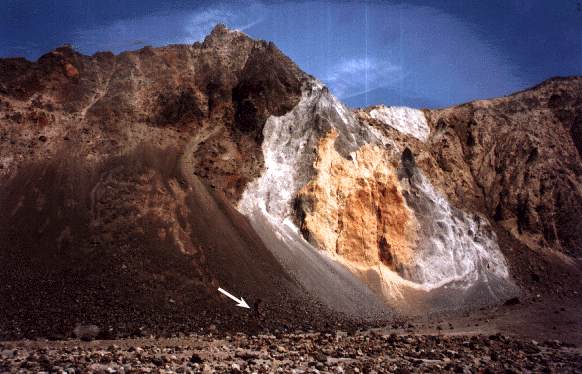

An avalanche is a large mass of moving fragments with blocks that range from 100's of meters (exceeding 1000 m) in longest dimensions, down to tiny particles less than 0.1 mm. They may form from the collapse of nearly any kind of rock, but the focus here is upon volcanic debris-flow avalanches that develop from the collapse of parts of volcanoes.
An avalanche typically starts movement on a slide plane, but then begins to disintegrate into separate particles that move against and over one another, with the small ones serving as the matrix that carries the larger particles, although this is not necessary for the movement of avalanches. The mass moves as a fluid and can attain speeds of 100 m/s. There is uusually abundant moisture around the fragments, derived from ground water initially retained in the rocks before they dissociated into large and small particles.
Gigantic avalanches can originate by the structural collapse of a composite volcanoes. The first witnessed debris-flow avalanche occurred with the collapse of the northern sector of Mount St. Helens, 18 May 1980. Since then, avalanche deposits have been inventoried world-wide. Although collapse is infrequent on a human life-span scale, it is a common volcanologic phenomenon of composite volcanoes. Composite volcanoes may grow to great heights if volcanic activity persists long enough, but the pull of gravity limits growth. Slopes steepen, they become unstable and then may collapse. A rising internal dome within the Mount St. Helens volcano contributed to the oversteepening and instability of its north slope. A volcanic earthquake triggered the collapse. The collapse unroofed the rising magma dome which rapidly depressurized and resulted in a lateral blast to the north. At other high-standing composite volcanoes, collapse from oversteepend slopes has occurred without accompanying blasts.
The avalanche deposit at Mount St. Helens, was divided into blocks and matrix. The blocks (with fine-grained matrix between them) are pieces of the old mountain transported to the place of deposition relatively intact. Some blocks at Mount St. Helens are 100 meters across and stand in hillocks, or hummocks, 73 meters above the level of the suface, and some are smeared out and broken. In other, older deposits, such as at Mount Shasta, hummocks of a 350,000 year old debris-avalanche on the north side of the mountain are over 100 meters high.
The matrix is the part of the debris-avalanche that is a complete and loose mixture of all the rock types from the old mountain, plus some material from the blast and some picked up from the ground during transport. Most blocks are partly to completly shattered, but locally there is a crude arrangement of separate fragments where original layering is roughly maintained like a three dimensional jigsaw puzzle.
Debris-flow avalanches may dam streams to form lakes that can drain catastrophically and generate lahars and floods. Debris avalanches that enter restricted bays and lakes may form very high waves, and those that enter the sea form tsunamis.
Debris avalanches commonly contain water-saturated parts of a volcano or incorporate water or saturated sediments as they move, therefore some deposits contain a lahar-like matrix between the large blocks and also injected into fractures in the blocks. If enough water is present, parts of an avalanche can transform directly into lahars or generate lahars by dewatering after they come to rest. Such lahars can transport blocks which are preserved as clasts within the lahar.
Volcanic debris avalanches together with associated laterally-directed eruptions and tsunamis, have resulted in more than 20,000 fatalities in the past 400 years. Nearly 50 percent of the active composite volcanoes and domes in Japan have generated significant debris avalanche events. The largest known debris avalanches in the past have traveled 50-100 km from their source and covered areas of 500-1500 square km. In central France is a large volcano known as Mont Cantal, which has excellent exposures of volcanic avalanche deposits.
The oldest mapped debris avalanche, the Castle Rocks Chaos of Eocene age in the Absaroka Mountains, Wyoming, USA, covers a minimum area of 1550 square km and contains blocks as large as 1.5 km in maximum length.
